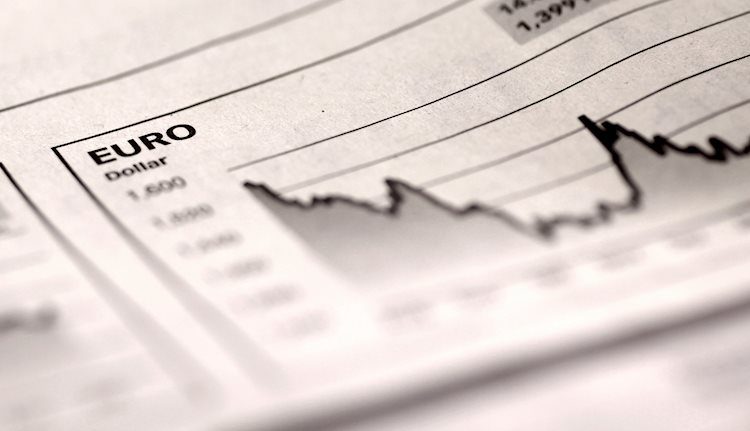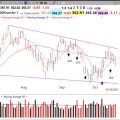- EUR/USD trades near 1.0550 following previous week’s sharp decline.
- The pair remains technically bearish in the short term despite stabilizing.
- ECB President Lagarde will deliver a speech later in the day.
EUR/USD managed to find a foothold on Friday but still lost nearly 1.7% in the previous week. The pair stays in a consolidation phase to begin the new week and trades at around 1.0550.
Euro PRICE Last 7 days
The table below shows the percentage change of Euro (EUR) against listed major currencies last 7 days. Euro was the weakest against the US Dollar.
| USD | EUR | GBP | JPY | CAD | AUD | NZD | CHF | |
|---|---|---|---|---|---|---|---|---|
| USD | 1.68% | 2.35% | 1.33% | 1.41% | 1.94% | 1.94% | 1.29% | |
| EUR | -1.68% | 0.62% | -0.26% | -0.16% | 0.34% | 0.35% | -0.30% | |
| GBP | -2.35% | -0.62% | -0.98% | -0.78% | -0.28% | -0.28% | -0.91% | |
| JPY | -1.33% | 0.26% | 0.98% | 0.09% | 0.53% | 0.70% | -0.02% | |
| CAD | -1.41% | 0.16% | 0.78% | -0.09% | 0.57% | 0.51% | -0.13% | |
| AUD | -1.94% | -0.34% | 0.28% | -0.53% | -0.57% | -0.02% | -0.64% | |
| NZD | -1.94% | -0.35% | 0.28% | -0.70% | -0.51% | 0.02% | -0.64% | |
| CHF | -1.29% | 0.30% | 0.91% | 0.02% | 0.13% | 0.64% | 0.64% |
The heat map shows percentage changes of major currencies against each other. The base currency is picked from the left column, while the quote currency is picked from the top row. For example, if you pick the Euro from the left column and move along the horizontal line to the US Dollar, the percentage change displayed in the box will represent EUR (base)/USD (quote).
Hawkish comments from Federal Reserve (Fed) officials caused investors to reassess the probability of one more 25 basis points rate cut in December last week, providing a boost to the US Dollar (USD) and weighing heavily on EUR/USD.
Monday’s economic calendar will not offer any high-impact data releases that could impact EUR/USD’s action. Hence, market participants will pay close attention to comments from central bank officials.
In the early American session, Chicago Fed President Austan Goolsbee will be delivering a speech. Speaking on the policy outlook on Friday, “I don’t like tying our hands,” Goolsbee said and added that they still have more data to come before deciding on the December policy decision. Later in the day, European Central Bank (ECB) President Christine Lagarde will deliver a speech titled “The Economic and Human Issues of a Changing Era” at an event organized by The Collège des Bernardins in Paris, France.
Meanwhile, investors will also keep an eye on geopolitical headlines. Over the weekend, CNN News reported that US President Joe Biden has authorized Ukraine to use powerful long-range American weapons to strike inside Russia. Reporting on the matter, “the change comes largely in response to Russia’s deployment of North Korean ground troops to supplement its own forces, a development that has caused alarm in Washington and Kyiv,” Reuters said.
US stock index futures trade marginally higher in the European morning but investors could seek refuge in case geopolitical tensions escalate further. A bearish opening in US stocks could help the USD regather its strength in the second half of the day.
EUR/USD Technical Analysis
EUR/USD seems to have stabilized following the previous week’s decline but the technical outlook remains bearish. The pair trades within the descending regression channel and the Relative Strength Index (RSI) indicator stays below 50.
On the downside, 1.0500 (mid-point of the descending channel) aligns as first support before 1.0440 (lower limit of the descending channel). Looking north, first resistance could be spotted at 1.0570 (upper limit of the descending channel) ahead of 1.0600 (round level) and 1.0650 (50-period Simple Moving Average).
Euro FAQs
The Euro is the currency for the 19 European Union countries that belong to the Eurozone. It is the second most heavily traded currency in the world behind the US Dollar. In 2022, it accounted for 31% of all foreign exchange transactions, with an average daily turnover of over $2.2 trillion a day. EUR/USD is the most heavily traded currency pair in the world, accounting for an estimated 30% off all transactions, followed by EUR/JPY (4%), EUR/GBP (3%) and EUR/AUD (2%).
The European Central Bank (ECB) in Frankfurt, Germany, is the reserve bank for the Eurozone. The ECB sets interest rates and manages monetary policy. The ECB’s primary mandate is to maintain price stability, which means either controlling inflation or stimulating growth. Its primary tool is the raising or lowering of interest rates. Relatively high interest rates – or the expectation of higher rates – will usually benefit the Euro and vice versa. The ECB Governing Council makes monetary policy decisions at meetings held eight times a year. Decisions are made by heads of the Eurozone national banks and six permanent members, including the President of the ECB, Christine Lagarde.
Eurozone inflation data, measured by the Harmonized Index of Consumer Prices (HICP), is an important econometric for the Euro. If inflation rises more than expected, especially if above the ECB’s 2% target, it obliges the ECB to raise interest rates to bring it back under control. Relatively high interest rates compared to its counterparts will usually benefit the Euro, as it makes the region more attractive as a place for global investors to park their money.
Data releases gauge the health of the economy and can impact on the Euro. Indicators such as GDP, Manufacturing and Services PMIs, employment, and consumer sentiment surveys can all influence the direction of the single currency. A strong economy is good for the Euro. Not only does it attract more foreign investment but it may encourage the ECB to put up interest rates, which will directly strengthen the Euro. Otherwise, if economic data is weak, the Euro is likely to fall. Economic data for the four largest economies in the euro area (Germany, France, Italy and Spain) are especially significant, as they account for 75% of the Eurozone’s economy.
Another significant data release for the Euro is the Trade Balance. This indicator measures the difference between what a country earns from its exports and what it spends on imports over a given period. If a country produces highly sought after exports then its currency will gain in value purely from the extra demand created from foreign buyers seeking to purchase these goods. Therefore, a positive net Trade Balance strengthens a currency and vice versa for a negative balance.




